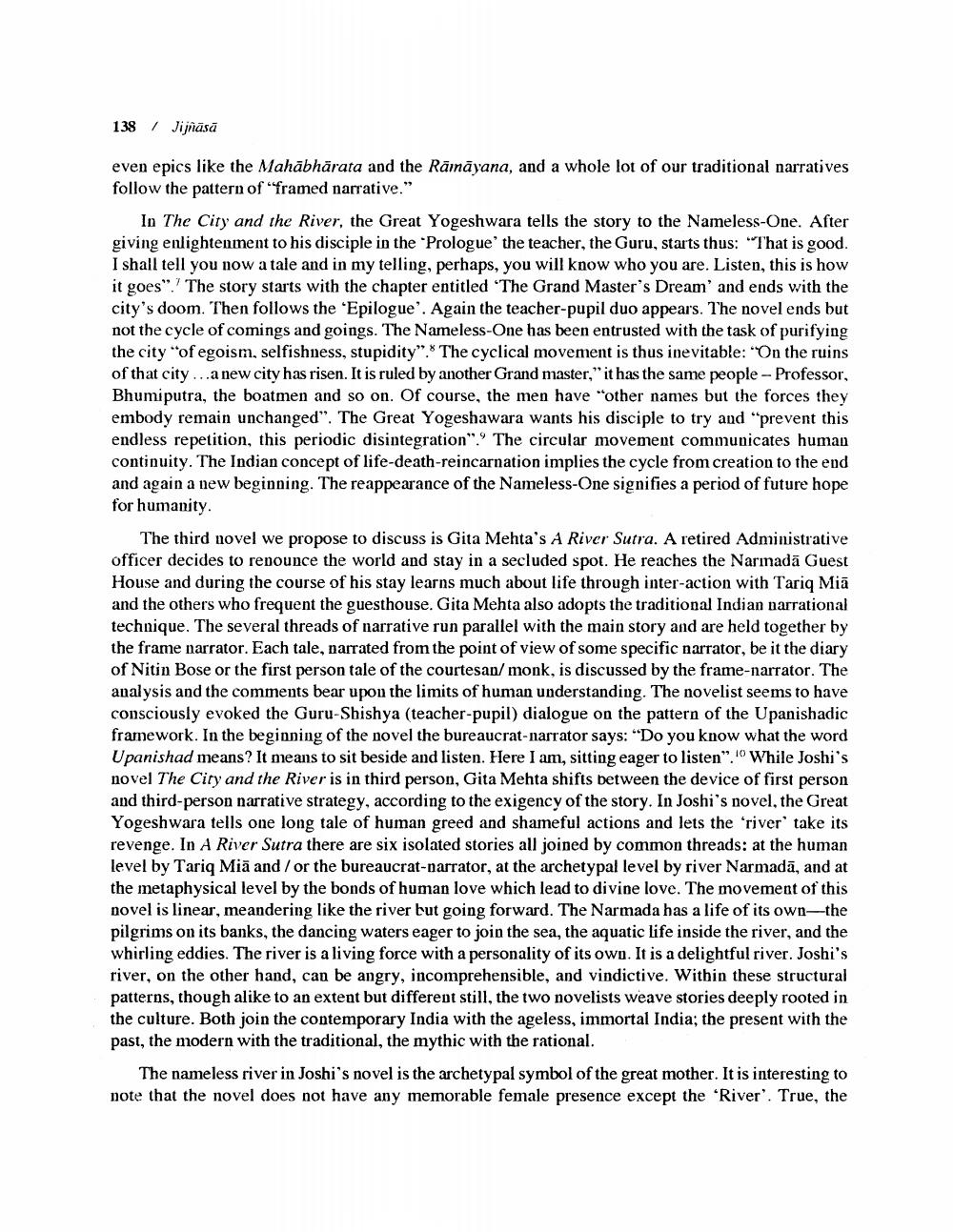________________
138 / Jijāsā
even epics like the Mahābhārata and the Rāmāyana, and a whole lot of our traditional narratives follow the pattern of " framed narrative."
In The City and the River, the Great Yogeshwara tells the story to the Nameless-One. After giving enlightenment to his disciple in the Prologue' the teacher, the Guru, starts thus: "That is good. I shall tell you now a tale and in my telling, perhaps, you will know who you are. Listen, this is how it goes". The story starts with the chapter entitled 'The Grand Master's Dream' and ends with the city's doom. Then follows the 'Epilogue'. Again the teacher-pupil duo appears. The novel ends but not the cycle of comings and goings. The Nameless-One has been entrusted with the task of purifying the city of egoism, selfishness, stupidity". The cyclical movement is thus inevitable: "On the ruins of that city ...a new city has risen. It is ruled by another Grand master," it has the same people - Professor, Bhumiputra, the boatmen and so on. Of course, the men have "other names but the forces they embody remain unchanged". The Great Yogeshawara wants his disciple to try and prevent this endless repetition, this periodic disintegration". The circular movement communicates human continuity. The Indian concept of life-death-reincarnation implies the cycle from creation to the end and again a new beginning. The reappearance of the Nameless-One signifies a period of future hope for humanity.
The third novel we propose to discuss is Gita Mehta's A River Sutra. A retired Administrative officer decides to renounce the world and stay in a secluded spot. He reaches the Narinadā Guest House and during the course of his stay learns much about life through inter-action with Tariq Miā and the others who frequent the guesthouse. Gita Mehta also adopts the traditional Indian narrational technique. The several threads of narrative run parallel with the main story and are held together by the frame narrator. Each tale, narrated from the point of view of some specific narrator, be it the diary of Nitin Bose or the first person tale of the courtesan/monk, is discussed by the frame-narrator. The analysis and the comments bear upon the limits of human understanding. The novelist seems to have consciously evoked the Guru-Shishya (teacher-pupil) dialogue on the pattern of the Upanishadic framework. In the beginning of the novel the bureaucrat-narrator says: “Do you know what the word Upanishad means? It means to sit beside and listen. Here I am, sitting eager to listen". While Joshi's novel The City and the River is in third person, Gita Mehta shifts between the device of first person and third-person narrative strategy, according to the exigency of the story. In Joshi's novel, the Great Yogeshwara tells one long tale of human greed and shameful actions and lets the 'river' take its revenge. In A River Sutra there are six isolated stories all joined by common threads: at the human level by Tariq Mia and / or the bureaucrat-narrator, at the archetypal level by river Narmadā, and at the metaphysical level by the bonds of human love which lead to divine love. The movement of this novel is linear, meandering like the river but going forward. The Narmada has a life of its own the pilgrims on its banks, the dancing waters eager to join the sea, the aquatic life inside the river, and the whirling eddies. The river is a living force with a personality of its own. It is a delightful river. Joshi's river, on the other hand, can be angry, incomprehensible, and vindictive. Within these structural patterns, though alike to an extent but different still, the two novelists weave stories deeply rooted in the culture. Both join the contemporary India with the ageless, immortal India, the present with the past, the modern with the traditional, the mythic with the rational.
The nameless river in Joshi's novel is the archetypal symbol of the great mother. It is interesting to note that the novel does not have any memorable female presence except the 'River'. True, the




